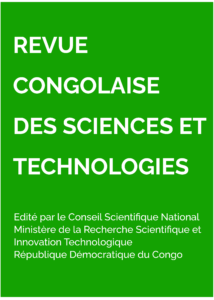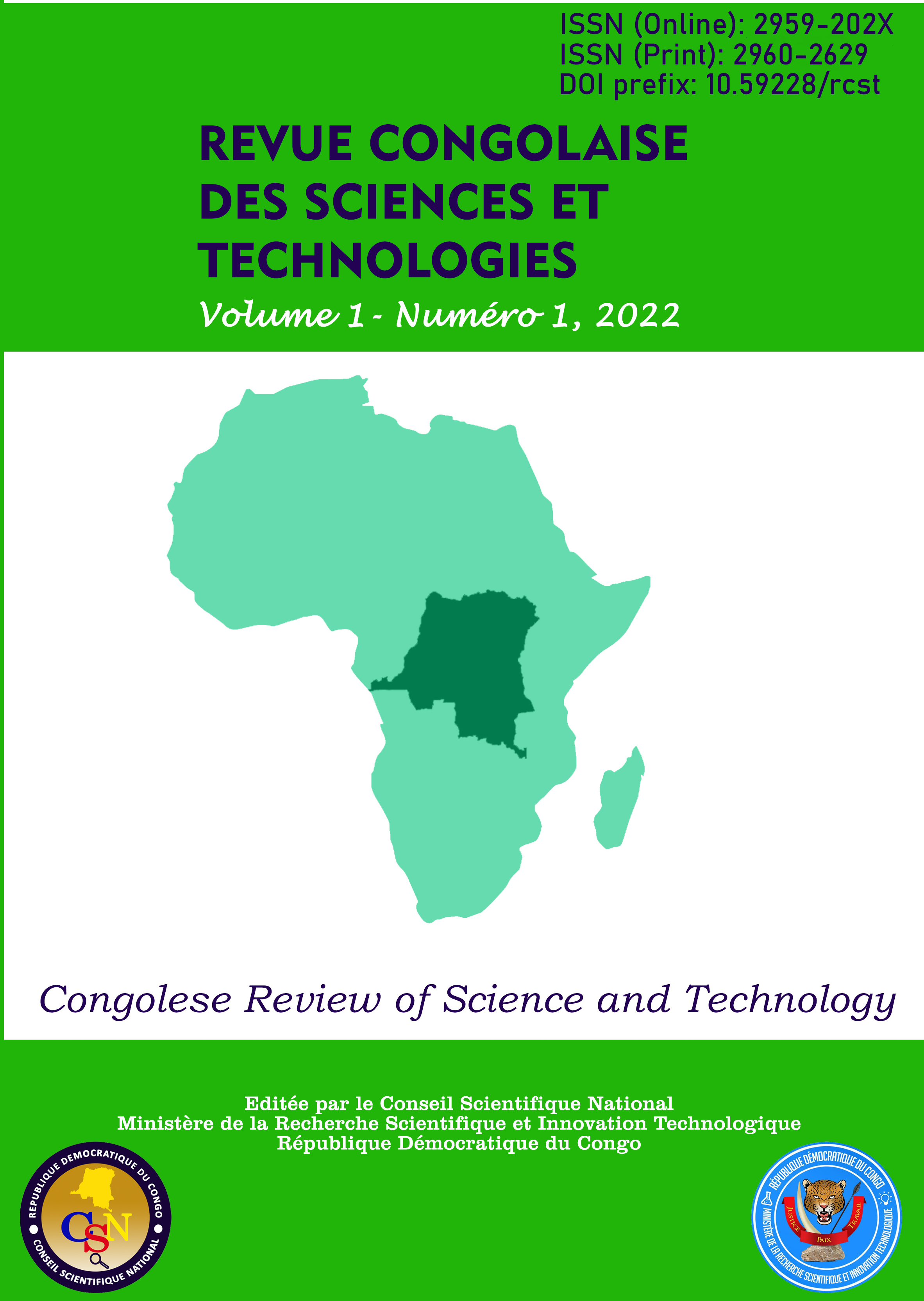Etude Comparée de la Flore Colonisatrice du Voisinage des Eaux Thermales aux Environs de la Ville de Bukavu (Sud-Kivu)
Contenu principal de l'article
Résumé
La présente étude contribue à la connaissance de la diversité de la flore et de la mise à jour des données floristiques de sites
des eaux thermales dans huit sites (Burhinzi, Luhwindja, Kankulé, Kakonde, Cimenki, Cizirhi, Buhandahanda, Nyangezi)
situés aux environs de la ville de Bukavu. La méthode phytosociologique a été utilisée dans une zone d’échantillonnage de 10
m, de part et d’autre du site, dans laquelle deux relevés de 4 m2
étaient réalisés. La méthode d’échantillonnage consistait à un
inventaire quantitatif afin de relever les divers indices d’abondances spécifiques. Les résultats montrent un inventaire des
espèces végétales présentes dans les sites thermaux regroupées en 33 familles, 83 genres et 101 espèces dont les familles
d’Asteraceae, Poaceae et Fabaceae sont les plus abondantes. Les herbes dominent sur les arbres et la plupart des flores
étudiées se regroupe dans les thérophytes. La comparaison de la richesse spécifique entre les différents sites sur base du test
ANOVA montre qu’il n’y a pas de différence significative entre les sites (P > 0 ,001 ; F=1,881).
Details de l'article
Rubrique

Ce travail est disponible sous licence Creative Commons Attribution - Pas d’Utilisation Commerciale - Partage dans les Mêmes Conditions 4.0 International.
Références
Bagalwa, M.L., Mashimango, J.J., Mateso, B.,
Katcho, K., Kaboyi, I. (2015).
“Caractérisation Physico-Chimique et
Identification Des Espèces Végétales
Indicatrices Des Eaux Thermales de Katana ,
Sud Kivu , République Démocratique Du
Congo Résumé Abstract.” Afrique SCIENCE
(5): 406–21.
Bagalwa, M.L., Mateso, L., Mashimango, B., Katcho,
K. (2015). “Hydrochemical Characterization
of Katana Thermals Waters, Lake Kivu
Watershed.” Scholars Journal of Engineering
and Technology 3 (1B): 98–103.
Barnby, M.A, Resh, V.H. (1988). “Factors Affecting
the Distribution of an Endemic and a
Widespread Species of Brine Fly ( Diptera :
Ephydridae ) in a Northern California Thermal
Saline Spring.” Entomological Society of
America 81: 437–46.
Brues, B.Y., Charles, T. (1927). “Animal Life in Hot
Springs.” Quar. Rev.Biol 2 (2): 181–203.
Collins, B.G., Brian, G., Rebelo, T. (1987).
“Pollination Biology of the Proteaceae in
Australia and Southern Africa.” Australian
Journal of Ecology 12: 387–421.
Ervin, G.N., Brook D. H., Bried, J.T., Holly, D.C.
(2006). “Evaluating non-native species and
wetland indicator status as components of
wetlands floristic assessment.” Wetlands 26
(4): 1114–29.
Kabonyi, N.C. (2012). “Analyse Palynologique de
Divers Sondages Du Secteur Haute Altitude
Du Parc National de Kahuzi- Biega.
Paleoenvironnements et Paléoclimats Au
Pleistocène Supérieur et à l’Holocène.”
Letouzey, R.G. (1989). “Spécialiste Incontesté de La
Botanique Des Forêts Du Cameroun.” In
Hommes et Destins, 479–81.
Maki, M.J.C., Dewitte, O. (2014). “Towards an
Inventory of Landslide Processes and the
Elements at Risk on the Rift Flanks West of
Lake Kivu ( DRC ).” Geo-Eco-Trop 38 (1, s.):
–54.
Villeneuve, M. (1980). “La Structure Du Rift
Africain Dans La R6gion Du Lac Kivu (Za~re
Oriental).” Bull. Volcanol 43 (3).
Vincent, W.F., Howard, W.C., Tildesley, P., Butler,
E., (1991). “Distribution and Biological
Properties of Oceanic Water Masses around
the South Island , New Zealand.” New
Zealand Journal of Marine & Freshwater
Research 25: 21–42.
https://doi.org/10.1080/00288330.1991.95164
Winterbourn, M.J. (1969). “The Distribution of
Algae and Insects in Hot Spring Thermal
Gradients at Waimangu , New Zealand.” New
Zealand Journal of Marine & Freshwater
Research 3: 459–65.
https://doi.org/10.1080/00288330.1969.95153
Winterbourn, M.J., Brown, T.J. (1967).
“Observations on the Faunas of Two Warm
Streams in the Taupo Thermal Region.” New
Zealand Journal of Marine & Freshwater
Research 1 (1): 38–50.
https://doi.org/10.1080/00288330.1967.95151
Alayat, H., Lamouroux, C. (2007). Caractérisation
physico-chimiques des eaux thermo-minérales
des monts de la Cheffia (extrême Nord-Est
Algérien). PressTherm. Climat. 144: 191–
Barnby, M.A., Resh,V.H. (1988). Factors affecting
the distribution of an endemic and a
Widespread Species of brine fly (Diptera:
Ephydridae)in a Northern California Thermal
Spring. Annals of the Entomological society
of America 81: 437-446.
Braun-Blanquet, J. (1932). Plant sociology. The
study of plant communities, McGraw-HIL
Book Company, Inc., New York, 407 p.
Brues, C.T. (1924). Observation on animal life in the
Thermal waters of Yellowstone Park, with a
consideration of the thermal environment,
proceeding of the American Academy of Arts
and Sciences 59, 371-437.
Brues, C.T. (1927). Anaimal life in the hot Spring.
Quarterly Review of Biology ,2, 181-203.
Brues, C.T. (1932). Further Studies on the fauna of
North American hot Springs. proceeding of
the American Academy of Arts and Sciences
: 186-303.
Ervin, G.N., Herman, B.D., Bried, J.T., Holly, D.C.
(2006). Evaluating non-native species and
wetland indicator status as components of
wetlands floristic assessment. Wetlands
:114-129.
Fischer, E. (1993). La végétation du Parc National de
Kahuzi-Biega (Sud-Kivu/Zaïre). Bonn, 93p.
Gotelli, N.J., Colwell, R.K. (2001). Quantifying
biodiversity: procedures and pitfalls in the
measurement and comparison of species
richness. , Ecol. Lett. 4: 379-391.
Hammer , ø., Harper, D.A.T. , Ryan, P.D. (2016).
Past, paleontological statisticssoftware
package for education and data analysis.
Palaeontologia Electronica 4(1): 9.
Jaze-Charvolin, M. R. (2014). «Les stations
thermales : de l’abandon à la renaissance. Une
brève histoire du thermalisme en France
depuis l’Antiquité », In Situ [En ligne], 24 |
,
http://journals.openedition.org/insitu/11123 ;
DOI : 10.4000/insitu.11123
Letouzey, R. (1982). Manuel de botanique forestière
de l’Afrique Tropicale. Tome 1, Centre
technique Forestier Tropical.
Mapenzi, A. (2010). Contribution à l’étude floristique
dans le secteur de Tshivanga.
Mashimango, B., Majaliwa, J.G.M., Mushagalusa N.,
Karume, K.. (2013). Estimation of
transported pollutant load from small urban
Kahuwa river micro-catchment in Lake Kivu,
Democratic Republic of Congo. Journal of
Environment Science and Engineering B 2
- 472.-[17].
Mashimango, B. , Mateso, B., Katcho, K. , Kaboyi,
I., Malengera, K., Nteranya, B., Ntadumba ,
N., Cinyambiriri, B. (2015). Caractérisation
physico-chimique et identification des espèces
végétales indicatrices des eaux thermales de
Katana , Sud Kivu , République Démocratique
du Congo, Afrique Science 11(5): 406- 421.
Mashimango, B., Bagalwa, M., Karume, K. (2015).
Hydrochemical characterization of Katana
thermals waters, Lake Kivu watershed.
Scholars Journal of Engineering and
Technology, 3 (1B) 98 – 10.
Mitchell, R. (1974). The evolution of thermophily in
hot Springs . Quartely Review of Biology, 49,
-242.
Ouali, S., Mehmah, B., Malek, A. (2007). Etude de
faisabilité d’utilisation des eaux thermales de
Zelfana Dans la Production d’Hydrogène.
IWH, Ghardaïa - Algeria, 9p.
Pielou, E.C. (1996). Species diversity and pattern in
the study of ecological succession. Theor.
Biol.10: 370-383.
PNKB, Sud-Kivu, RD Congo.annales des sciences
de l’UOB , vol. 2. 2010.
Schoeman, F.R., Archibald, R.E.M. (1988).
Taxonomic notes on the diatoms
(Bacillariophyceae) of the cross Barmen
Thermal Springs in south West Africa
/Namibea. South African Journal of Botany
: 221-256.
Senterre, B. (2005). Recherches méthodologiques
pour la typologie de la végétation et la
Phytogéographie des forêts denses d’Afrique
Tropicale. Thèse de doct. ULB. Labo. Bot.
Syst. &Phyt. 345p. + Annexes.
Shanonn, C.E., Weaver, E.W. (1949). The
mathematical theory of communication. Univ.
of Illino.
Simpson, E.H. (1949). Measurement of diversity,
Nature 163: 688.
Staruhlner, F. (1969). Beitrage zur kenntnis der
biozonosen islandischer thermalge wasser.
Sitzungsberichte osterreichische akademie der
wissenschaften.Mathematish–
Naturxissenschaftliche Klasse. Abteilung I,
: 83-173.
Stirling, G., Wilsey, B. (2001). Empirical
relationships between species richness,
evenness and proportional diversity. Am. Nat.
: 286-299.
Stockener, J.G. (1968). Algal growth and primary
productivity in a thermal stream. Journal of
the Fischeries Research Board of Canada, 25,
-2058.
Stockener, J.G. (1971). Ecological energetics and
natural history of Hedriodiscus truqui(
Diptera) in two Thermal Spring communities.
Journal pf the Fisheries Research Board of
Canada 28: 73-94.
Tuxen, S.L. (1944). The hot Spring, their animal
communities and their zoogeographical
significance. In the zoology of Iceland, vol. 1,
Part II, 1-216. Ejnar Munksgaord,
Copenhagen.
Vincent, W.F., Forsyth, D.J. (1987). Iland waters of
New Zeland . PP. 349-375. DPSIR. Science
information publishing center, Wellington.
Vouk A. (1919). Biolog. Unters.
ThermalquellenKroatiens and Slavoniens.
Bullet. Acad. d. Sc. Slav. du sud. Zagreb, 5
(191G), 8.
Vuathier, CH. (1926). Notes sur la flore thermale des
eaux sulfureuses de Mérens (Ariège), Bulletin
de la Société Botanique de France 73:3, 388-
, DOI: 10.1080/00378941.1926.10833594.
Wiegert, R.G. (1973). A general ecological model
and its use in stimulating algal- fly energetic
in a thermal Spring community. In :Insects :
stydies in population Management
(P.W.Geier, L.R.Clark, D.J.Anderson &
H.A.Nix, eds), 85-102.Ecology Society of
Australia(Memoirs1), cauberra.
Winterbourn, M.J. (1968). The faunas of thermal
waters in New Zealand. Tuatara 16: 111-122.
Winterbourn, M.J. (1969). The distribution of algae
and Insects in hot spring thermal gradients at
waimangu, new Zealand. New Zealand journal
of Marine and Freshwater Research 3: 459-

